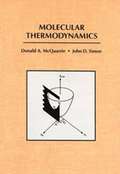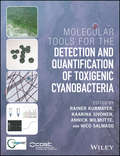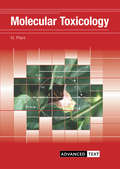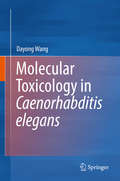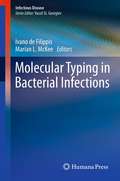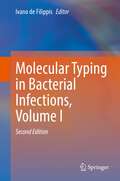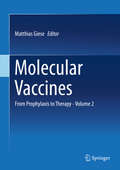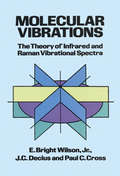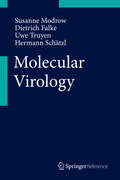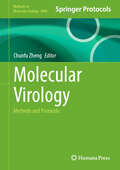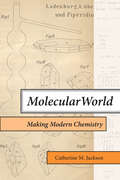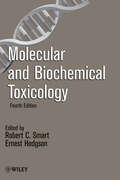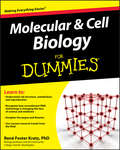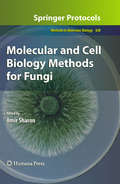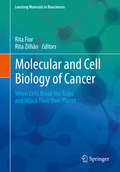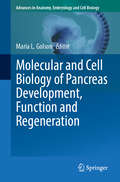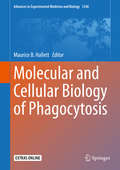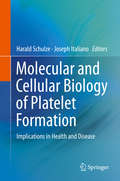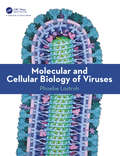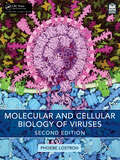- Table View
- List View
Molecular Thermodynamics
by Donald A. Mcquarrie John D. SimonThis text covers the principles of quantum mechanics before engaging those ideas in the subsequent development of thermodynamics. It includes worked examples and chapter-ending problems with solutions.
Molecular Tools for the Detection and Quantification of Toxigenic Cyanobacteria
by Annick Wilmotte Kaarina Sivonen Nico Salmaso Rainer KurmayerA guide to state-of-the-art molecular tools for monitoring and managing the toxigenicity of cyanobacteria Runaway eutrophication and climate change has made the monitoring and management of toxigenic organisms in the world’s bodies of water more urgent than ever. In order to influence public policy regarding the detection and quantification of those organisms, it is incumbent upon scientists to raise the awareness of policy makers concerning the increased occurrence of toxigenic cyanobacteria and the threats they pose. As molecular methods can handle many samples in short time and help identify toxigenic organisms, they are reliable, cost-effective tools available for tracking toxigenic cyanobacteria worldwide. This volume arms scientists with the tools they need to track toxigenicity in surface waters and food supplies and, hopefully, to develop new techniques for managing the spread of toxic cyanobacteria. This handbook offers the first comprehensive treatment of molecular tools for monitoring toxigenic cyanobacteria. Growing out of the findings of the landmark European Cooperation in Science and Technology Cyanobacteria project (CYANOCOST), it provides detailed, practical coverage of the full array of available molecular tools and protocols, from water sampling, nucleic acid extraction, and downstream analysis—including PCR and qPCR based methods—to genotyping (DGGE), diagnostic microarrays, and community characterization using next-gen sequencing techniques. Offers an overview of the latest trends in the field, while providing a foundation for understanding and applying the tools and techniques described Provides detailed coverage of the full range of molecular tools currently available, with expert guidance on the analysis and interpretation of results Includes step-by-step guidance on standard operational procedures, including molecular tests used in environmental monitoring, with individual chapters devoted to each procedure Complements the published Handbook of Cyanobacterial Monitoring and Cyanotoxin Analysis from the CyanoCOST project This handbook is an indispensable working resource for scientists, lab technicians, and water management professionals and an excellent text/reference for graduate students and supervisors who use molecular tools. It will also be of great value to environmental health and protection officials and policy makers.
Molecular Toxicology (Advanced Texts)
by Nick PlantMolecular Toxicology is a concise introduction to the subject, taking the reader through the theoretical principles of toxicology followed by specific examples. In the first section, the concepts behind possible mechanisms of toxicity are described (e.g. the specific enzyme or receptor system) using examples where appropriate. Following this a series of examples are used to show the extension of concept into the real world, in an organ specific manner. The book concludes with a section outlining toxicity assessment methods, where the impact of molecular biology is having a considerable impact, including DNA microarrays, proteomics and bioinformatics.
Molecular Toxicology Protocols (Methods in Molecular Biology #2102)
by Phouthone Keohavong Kamaleshwar P. Singh Weimin GaoThis fully revised book includes new and improved protocols to analyze toxicity at the DNA, RNA, and protein levels using genomic, epigenomic, transcriptomic, and proteomic approaches. Sections of the book address key subjects such as bioinformatics and biostatistics, toxicant-induced lung inflammation and tumors, analysis of protein and gene expression and silencing, gene promoter methylation, detection of chromosomal and genome-wide damage, analysis of DNA-adducts and surrogate gene mutations, detection and characterization of cancer gene mutation, and many other areas of study. Written for the highly successful Methods in Molecular Biology series, chapters include introductions to their respective topics, lists of the necessary materials and reagents, step-by-step, readily reproducible laboratory protocols, and tips on troubleshooting and avoiding known pitfalls. Comprehensive and up-to-date, Molecular Toxicology Protocols, Third Edition will prove to play an important role in generating a better understanding of the field of toxicology and its sub-disciplines.
Molecular Toxicology in Caenorhabditis elegans
by Dayong WangThis book will focus on the molecular basis of oxidative stress induced by toxicants or stresses and various molecular signalling pathways in regulating the toxicity of toxicants or stresses in Caenorhabditis elegans. It will also cover the discussion on the aspects of response signals, G-protein coupled receptors and ion channels, specific molecular signals, and epigenetic signals involved in the regulation of toxicity from toxicants or stresses. The molecular basis for adaptive response for transgenerational toxicity of environmental toxicants or stresses will be further discussed. Nematode Caenorhabditis elegans is a classic model animal with well-described genetic and developmental backgrounds based on the study of life science, and has been further successfully and widely used in both toxicity assessment and toxicological study of various environmental toxicants or stresses. Based on related available data, this book aims at providing a systematic understanding of the knowledge system of molecular toxicology in C. elegans.
Molecular Typing in Bacterial Infections
by Marian L. Mckee Ivano De FilippisMolecular Typing in Bacterial Infections covers common bacterial pathogenic agents, with the most effective methods for their identification and classification in the light of their specific epidemiology. The book will be a valuable resource for molecular typing of infectious diseases agents encountered in both the research and hospital clinical lab settings, as well as culture collections. Each chapter provides an overview of molecular approaches to typing bacterial pathogens. Part I gives a general overview of typing methods used in the traditional microbiology laboratory in comparison to molecular methods of epidemiology. In Part II, the relative strengths and weaknesses of the different methods applicable to the specific agents of infectious diseases are emphasized. Specific emphasis is placed on recent changes and updates in molecular typing.
Molecular Typing in Bacterial Infections, Volume I
by Ivano De FilippisThis updated second edition of Molecular Typing in Bacterial Infections, presented in two volumes, covers both common and neglected bacterial pathogenic agents, highlighting the most effective methods for their identification and classification in the light of their specific epidemiology. New chapters have been included to add new species, as well as another view of how bacterial typing can be used. These books are valuable resources for the molecular typing of infectious disease agents encountered in both research and hospital clinical laboratory settings, as well as in culture collections and in the industry. Each of the 21 chapters provides an overview of specific molecular approaches to efficiently detect and type different bacterial pathogens. The chapters are grouped in five parts, covering respiratory and urogenital pathogens (Volume I), and gastrointestinal and healthcare-associated pathogens, as well as a new group of vector-borne and Biosafety level 3 pathogens including a description of typing methods used in the traditional microbiology laboratory in comparison to molecular methods of epidemiology (Volume II). Comprehensive and updated, Molecular Typing in Bacterial Infections provides state-of-the-art methods for accurate diagnosis and for the correct classification of different types which will prove to be critical in unravelling the transmission routes of human pathogens.
Molecular Typing in Bacterial Infections, Volume II
by Ivano De FilippisThis updated second edition of Molecular Typing in Bacterial Infections, presented in two volumes, covers both common and neglected bacterial pathogenic agents, highlighting the most effective methods for their identification and classification in the light of their specific epidemiology. New chapters have been included to add new species, as well as another view of how bacterial typing can be used. These books are valuable resources for the molecular typing of infectious disease agents encountered in both research and hospital clinical laboratory settings, as well as in culture collections and in the industry. Each of the 21 chapters provides an overview of specific molecular approaches to efficiently detect and type different bacterial pathogens. The chapters are grouped in five parts, covering respiratory and urogenital pathogens (Volume I), and gastrointestinal and healthcare-associated pathogens, as well as a new group of vector-borne and Biosafety level 3 pathogens including a description of typing methods used in the traditional microbiology laboratory in comparison to molecular methods of epidemiology (Volume II). Comprehensive and updated, Molecular Typing in Bacterial Infections provides state-of-the-art methods for accurate diagnosis and for the correct classification of different types which will prove to be critical in unravelling the transmission routes of human pathogens.
Molecular Vaccines
by Matthias GieseThis book gives a comprehensive overview to all aspects of global molecular vaccine research. It introduces concepts of vaccine immunology and molecular vaccine development for viral, bacterial, parasitic and fungal infections. Furthermore, the broad field of research and development in molecular cancer vaccines is discussed in detail. This book is a must have for scientists and clinicians interested in new developments in molecular vaccine research and application in infections and cancer.
Molecular Vibrations: The Theory of Infrared and Raman Vibrational Spectra (Dover Books on Chemistry)
by E. Bright Wilson Jr. J. C. Decius Paul C. CrossBecause of its connection with laser technology, the theory of infrared and Raman vibrational spectra is even more important now than when this book was first published. As the pioneering text in the field and as the text still preferred today, Molecular Vibrations is the undeniable choice of anyone teaching or studying molecular spectroscopy at the graduate level. It is the only book of its kind in the area written by well-known scientists, and besides its value as a pedagogical classic, it is an essential reference for anyone engaged in research. The genius of the book is its rigorous, elegant treatment of the mathematics involved in detailed vibrational analyses of polyatomic molecules. The reader is led carefully and gradually through the main features of the theory and its methods: starting from a valuable introduction to the theory of molecular vibrations and the application of wave mechanics to this subject; leading into the mathematical methods devised by Professor Wilson and his students for handling the mathematical problems and for making use of symmetry and group theory; proceeding through vibrational selection rules and intensities, potential functions and methods of solving the secular determinant; and concluding with a sample vibrational analysis of the molecule of benzene. Sixteen appendices, comprising nearly one hundred pages, offer much extremely useful information that is more clearly understood outside the body of the text. Well-known for their distinguished contributions to the field, the authors -- in addition to Professor Wilson of Harvard University -- are J. C. Decius of Oregon State University and Paul C. Cross, late President of Mellon Institute. Younger students interested in the field of molecular spectroscopy will especially welcome this inexpensive reprint edition of an exceptional book. "An authoritative and complete presentation written on a very high level." -- G. Herzberg, Science"The easiest and quickest route to acquiring skill in handling the mathematics of molecular vibrations." -- Nature
Molecular Virology
by Dietrich Falke Hermann Schätzl Susanne Modrow Uwe TruyenThe book gives a comprehensive overview on the knowledge of virus infection relevant for humans and animals. For each virus family the molecular details of the virus particle and the viral replication cycle are described. In the case of virus types with relevance for human and/or animal health the data on molecular biology, genetics and virus-cell interaction are combined with those concerning, pathogenesis, epidemiology, clinics, prevention and therapy.
Molecular Virology: Methods and Protocols (Methods in Molecular Biology #2940)
by Chunfu ZhengThis detailed book presents classical and cutting-edge techniques in molecular virology research. The volume begins with guidelines for investigating viral structure, proliferation processes, and virulence factors, followed by various approaches to identify key elements and molecular signaling pathways in virus-infected host cells that regulate virus-host interactions. Additional chapters explore methods for studying autophagy, post-translational modifications of virus and host proteins, epigenetic factors in anti-viral immune responses, and viral epidemiology. Written for the highly successful Methods in Molecular Biology series, chapters include introductions to their respective topics, lists of the necessary materials and reagents, step-by-step and readily reproducible laboratory protocols, and tips on troubleshooting and avoiding known pitfalls. Authoritative and practical, Molecular Virology: Methods and Protocols serves as an ideal guide to this vitally important area of study.
Molecular World: Making Modern Chemistry
by Catherine M. JacksonA compelling and innovative account that reshapes our view of nineteenth-century chemistry, explaining a critical period in chemistry&’s quest to understand and manipulate organic nature.According to existing histories, theory drove chemistry&’s remarkable nineteenth-century development. In Molecular World, Catherine M. Jackson shows instead how novel experimental approaches combined with what she calls &“laboratory reasoning&” enabled chemists to bridge wet chemistry and abstract concepts and, in so doing, create the molecular world. Jackson introduces a series of practice-based breakthroughs that include chemistry&’s move into lampworked glassware, the field&’s turn to synthesis and subsequent struggles to characterize and differentiate the products of synthesis, and the gradual development of institutional chemical laboratories, an advance accelerated by synthesis and the dangers it introduced.Jackson&’s historical reassessment emerges from the investigation of alkaloids by German chemists Justus Liebig, August Wilhelm Hofmann, and Albert Ladenburg. Stymied in his own research, Liebig steered his student Hofmann into pioneering synthesis as a new investigative method. Hofmann&’s practice-based laboratory reasoning produced a major theoretical advance, but he failed to make alkaloids. That landmark fell to Ladenburg, who turned to cutting-edge theory only after his successful synthesis.In telling the story of these scientists and their peers, Jackson reveals organic synthesis as the ground chemists stood upon to forge a new relationship between experiment and theory—with far-reaching consequences for chemistry as a discipline.
Molecular and Biochemical Toxicology
by Ernest Hodgson Robert C. SmartAn essential resource for graduate students, academic and industrial toxicologists, and environmental health scientists and professionalsOver the course of thirty years and three editions, Introduction to Biochemical Toxicology has been an important source for coverage of the ongoing quest to define the biochemical, cellular, and molecular events induced by toxicants at the cellular and organismic levels. Now, as the principles and methods of molecular and cellular biology as well as genomic sciences play an ever increasing role in mechanistic toxicology, significant changes have been made to the book, resulting in this important new edition-now titled Molecular and Biochemical Toxicology, Fourth Edition.Much more than an introductory text, this crucial new edition has been completely revised to provide timely and thorough coverage of the underlying biochemical, molecular, and cellular mechanisms through which toxicants produce their adverse effects. Toxicological issues are covered from the molecule to the cell to the organ level. Complex methods used in toxicology are also described in a straightforward, easy-to-understand style. Additional features of this new edition include:New chapters that explore the interface between toxicology and genomic sciences, including: bioinformatics, proteomics, metabolomics, and toxicogenomicsIncreased emphasis on structure, mechanism, and regulation of xenobiotic metabolizing enzymes, toxicogenetics, and xenobiotic transportersAdditional new chapters on: molecular epidemiology and genetic susceptibility, DNA damage and mutagenesis, DNA repair, mechanisms of cell death, mitochondrial dysfunction, metals, reproductive toxicology, developmental toxicology, and reactive oxygen/metabolites and toxicityMolecular and Biochemical Toxicology, Fourth Edition guides graduate students, toxicologists, and environmental health professionals through the principles of molecular and biochemical toxicology and the complex mechanisms of toxicity. Whether it's used in the classroom or in industry, research, or academia, this book is essential for anyone interested in understanding the molecular mechanisms through which toxicants produce adverse effects.
Molecular and Biochemical Toxicology
by Ernest Hodgson Robert C. SmartWritten as an advanced text for toxicology students, this book is much more than an introduction and provides in-depth information describing the underlying mechanisms through which toxicants produce their adverse responses.• Links traditional toxicology to modern molecular techniques, important for teaching to graduate courses and professional studies• Uses a didactic approach with basic biological or theoretical background for the methodology presented• Brings together and comprehensively covers a range of dynamic aspects in biochemical and molecular toxicology• Guides student and professional toxicologists in comprehending a broad range of issues, compiled and authored by a diverse group of experts• “A good introductory textbook covering the biochemical toxicology of organic substances and the relevant methodology in some detail.... It offers good value for money and can be recommended as a textbook for appropriate courses” – BTS Newsletter review of the 4th edition
Molecular and Biotechnological Tools for Plant Disease Management (Interdisciplinary Biotechnological Advances)
by Jayanta Kumar Patra Jen-Tsung Chen Masudulla Khan Aiman ParveenThis book aims to present the latest advances in the application of plant biotechnology and molecular biology in disease management. Among these, molecular techniques can be used to accelerate the detection and identification of pests and pathogens in plants. Also, the identification of resistance genes, characterization of desired resistance genes, and transfer of resistance gene(s) into plants have been performed by applying molecular techniques. The book will collect chapters exploring emerging areas of plant biotechnology including RNAi technology, genetic engineering, GWAS, CRISPR, and nanobiotechnology, and their applications in plant disease management and provides the latest concepts and advances in the field of plant pathology, including detection, identification, characterization, classification and diagnosis, host resistance, disease forecasting, management of plant pests and pathogens, and plant biotechnological approaches. This book offers a valuable reference for educators, students, and researchers in all disciplines of the agricultural sciences, life sciences, and biotechnology at universities, research institutions, and biotechnology companies.
Molecular and Cell Biology For Dummies
by Rene Fester KratzYour hands-on study guide to the inner world of the cellNeed to get a handle on molecular and cell biology? This easy-to-understand guide explains the structure and function of the cell and how recombinant DNA technology is changing the face of science and medicine. You discover how fundamental principles and concepts relate to everyday life. Plus, you get plenty of study tips to improve your grades and score higher on exams! Explore the world of the cell - take a tour inside the structure and function of cells and see how viruses attack and destroy them Understand the stuff of life (molecules) - get up to speed on the structure of atoms, types of bonds, carbohydrates, proteins, DNA, RNA, and lipids Watch as cells function and reproduce - see how cells communicate, obtain matter and energy, and copy themselves for growth, repair, and reproduction Make sense of genetics - learn how parental cells organize their DNA during sexual reproduction and how scientists can predict inheritance patterns Decode a cell's underlying programming - examine how DNA is read by cells, how it determines the traits of organisms, and how it's regulated by the cell Harness the power of DNA - discover how scientists use molecular biology to explore genomes and solve current world problemsOpen the book and find: Easy-to-follow explanations of key topics The life of a cell - what it needs to survive and reproduce Why molecules are so vital to cells Rules that govern cell behavior Laws of thermodynamics and cellular work The principles of Mendelian genetics Useful Web sites Important events in the development of DNA technology Ten great ways to improve your biology grade
Molecular and Cell Biology Methods for Fungi
by Amir SharonWith the development of fungal transformation systems and the deciphering of an increasing number of fungal genomes, this diverse clade of heterotrophic eukaryotic organisms has proven to be ideal for molecular work and highly serviceable as model systems to study basic processes with results that are applicable to many organisms, including humans. In Molecular and Cell Biology Methods for Fungi, experts in the field provide an up-to-date set of practical protocols covering a range of frequently used methods used to study molecular and cellular aspects of fungal biology. The included classical protocols such as transformation systems and traditional protein analysis methods, which have been widely used for many years, alongside the most advanced techniques such as genome amplification, whole genome knockout methods, and sophisticated in vivo imaging techniques will prove to be easily adaptable and useful in a wide range of species. Written in the highly successful Methods in Molecular BiologyTM series format, chapters include introductions to their respective topics, lists of the necessary materials and reagents, step-by-step, readily reproducible laboratory protocols, and notes on troubleshooting and avoiding known pitfalls. Comprehensive and up-to-date, Molecular and Cell Biology Methods for Fungi seeks to provide cutting-edge techniques in order to aid both experienced fungal research laboratories as well as those that are interested in using fungi as hosts to study their favorite genes.
Molecular and Cell Biology of Cancer: When Cells Break the Rules and Hijack Their Own Planet (Learning Materials in Biosciences)
by Rita Fior Rita ZilhãoThis textbook takes you on a journey to the basic concepts of cancer biology. It combines developmental, evolutionary and cell biology perspectives, to then wrap-up with an integrated clinical approach.The book starts with an introductory chapter, looking at cancer in a nut shell. The subsequent chapters are detailed and the idea of cancer as a mass of somatic cells undergoing a micro-evolutionary Darwinian process is explored. Further, the main Hanahan and Weinberg “Hallmarks of Cancer” are revisited. In most chapters, the fundamental experiments that led to key concepts, connecting basic biology and biomedicine are highlighted. In the book’s closing section all of these concepts are integrated in clinical studies, where molecular diagnosis as well as the various classical and modern therapeutic strategies are addressed. The book is written in an easy-to-read language, like a one-on-one conversation between the writer and the reader, without compromising the scientific accuracy. Therefore, this book is suited not only for advanced undergraduates and master students but also for patients or curious lay people looking for a further understanding of this shattering disease
Molecular and Cell Biology of Pancreas Development, Function and Regeneration (Advances in Anatomy, Embryology and Cell Biology #239)
by Maria L. GolsonThis book reviews recent advances in pancreatic endocrine and exocrine tissue development, function and regeneration. It provides a comprehensive overview on different aspects of beta-cell biology, including heterogeneity of function and gene expression and function, epigenetics, RNA and protein expression contributions to beta-cell specification and cell-fate maintenance. Furthermore, it covers recent progress in differentiating functional islets in vivo, environmental impacts on beta-cell development and function, and communications between various islet endocrine cells and how they contribute to the regulation of blood glucose homeostasis.The book provides a comprehensive resource for understanding the various compartments of the pancreas and is aimed at pancreas, beta-cell biology, and diabetes researchers.
Molecular and Cellular Biology of Phagocytosis (Advances in Experimental Medicine and Biology #1246)
by Maurice B. HallettPhagocytosis is the engulfment of particulate matter by cells. It is a fundamental (and probably “primitive”) cell biological process which is important in single celled organisms such as amoeba; multicellular animals including coelenterates; and in higher animals. In humans and other mammals, specialised immune cells (phagocytes) utilise phagocytosis in their crucial role of engulfing and destroying infecting microbes. Yet, surprisingly, the biophysics and biochemistry underlying the process has only become clear recently with the advent of genetic manipulation and advances in single cell imaging. In this volume, the aim is to bring together recent fundamental advances that give a clear picture of the underlying mechanism involved in phagocytosis. Not only is this an important topic in its own right, but a full understanding of the process will have a potential impact on human medicine, since as antibiotics become less effective in fight infection, researchers are looking at alternative approaches, including enhancing the “natural” immunity brought about by immune phagocytes.The aim is to provide a comprehensive volume on the topic, with separate chapters on identified recent advances, each written by the major contributors in each area. In addition, the volume will attempt to give a wider overview than is often the case in single author reviews, with an emphasis here on the cell biological understanding of phagocytosis using biophysical approaches alongside the biochemical and imaging approaches.
Molecular and Cellular Biology of Platelet Formation
by Harald Schulze Joseph ItalianoThis book gives a comprehensive insight into platelet biogenesis, platelet signal transduction, involvement of platelets in disease, the use of diverse animal models for platelet research and future perspectives in regard to platelet production and gene therapy. Being written by international experts, the book is a concise state-of-the art work in the field of platelet biogenesis, biology and research. It represents an indispensable tool for research scientists in biomedicine, vascular biology, hematopoiesis and hemostasis and specifically for scientists in platelet research, as well as for clinicians in the field of hematology and transfusion medicine.
Molecular and Cellular Biology of Viruses
by Phoebe LostrohViruses interact with host cells in ways that uniquely reveal a great deal about general aspects of molecular and cellular structure and function. Molecular and Cellular Biology of Viruses leads students on an exploration of viruses by supporting engaging and interactive learning. All the major classes of viruses are covered, with separate chapters for their replication and expression strategies, and chapters for mechanisms such as attachment that are independent of the virus genome type. Specific cases drawn from primary literature foster student engagement. End-of-chapter questions focus on analysis and interpretation with answers being given at the back of the book. Examples come from the most-studied and medically important viruses such as HIV, influenza, and poliovirus. Plant viruses and bacteriophages are also included. There are chapters on the overall effect of viral infection on the host cell. Coverage of the immune system is focused on the interplay between host defenses and viruses, with a separate chapter on medical applications such as anti-viral drugs and vaccine development. The final chapter is on virus diversity and evolution, incorporating contemporary insights from metagenomic research. Key selling feature: Readable but rigorous coverage of the molecular and cellular biology of viruses Molecular mechanisms of all major groups, including plant viruses and bacteriophages, illustrated by example Host-pathogen interactions at the cellular and molecular level emphasized throughout Medical implications and consequences included Quality illustrations available to instructors Extensive questions and answers for each chapter
Molecular and Cellular Biology of Viruses
by Phoebe LostrohThis fully revised second edition of Molecular and Cellular Biology of Viruses leads students on an exploration of viruses by supporting engaging and interactive learning. All the major classes of viruses are covered, with separate chapters for their replication and expression strategies, and chapters for mechanisms such as attachment that are independent of the virus genome type. Specific cases drawn from primary literature foster student engagement. End-of-chapter questions focus on analysis and interpretation with answers being given at the back of the book. Examples come from the most-studied and medically important viruses such as SARS-CoV-2, HIV, and influenza. Plant viruses and bacteriophages are also included. There are chapters on the overall effect of viral infection on the host cell. Coverage of the immune system is focused on the interplay between host defenses and viruses, with a separate chapter on medical applications such as antiviral drugs and vaccine development. The final chapter is on virus diversity and evolution, incorporating contemporary insights from metagenomic research. The second edition has updated suggestions for primary literature to discuss along with each chapter. New to this second edition, a supplementary chapter, freely available for download, looks at how virology intersects with public health, and uses the COVID-19 pandemic as a notable example.Key Features Readable but rigorous coverage of the molecular and cellular biology of viruses Molecular mechanisms of all major groups, including plant viruses and bacteriophages, illustrated by example Host-pathogen interactions at the cellular and molecular level emphasized throughout Medical implications and consequences included Quality illustrations available to instructors New to this second edition, interactive quiz questions hosted online
Molecular and Cellular Biophysics
by Meyer B. JacksonMolecular and Cellular Biophysics provides advanced undergraduate and graduate students with a foundation in the basic concepts of biophysics. Students who have taken physical chemistry and calculus courses will find this book an accessible and valuable aid in learning how these concepts can be used in biological research. The text provides a rigorous treatment of the fundamental theories in biophysics and illustrates their application with examples. Conformational transitions of proteins are studied first using thermodynamics, and subsequently with kinetics. Allosteric theory is developed as the synthesis of conformational transitions and association reactions. Basic ideas of thermodynamics and kinetics are applied to topics such as protein folding, enzyme catalysis and ion channel permeation. These concepts are then used as the building blocks in a treatment of membrane excitability. Through these examples, students will gain an understanding of the general importance and broad applicability of biophysical principles to biological problems.
